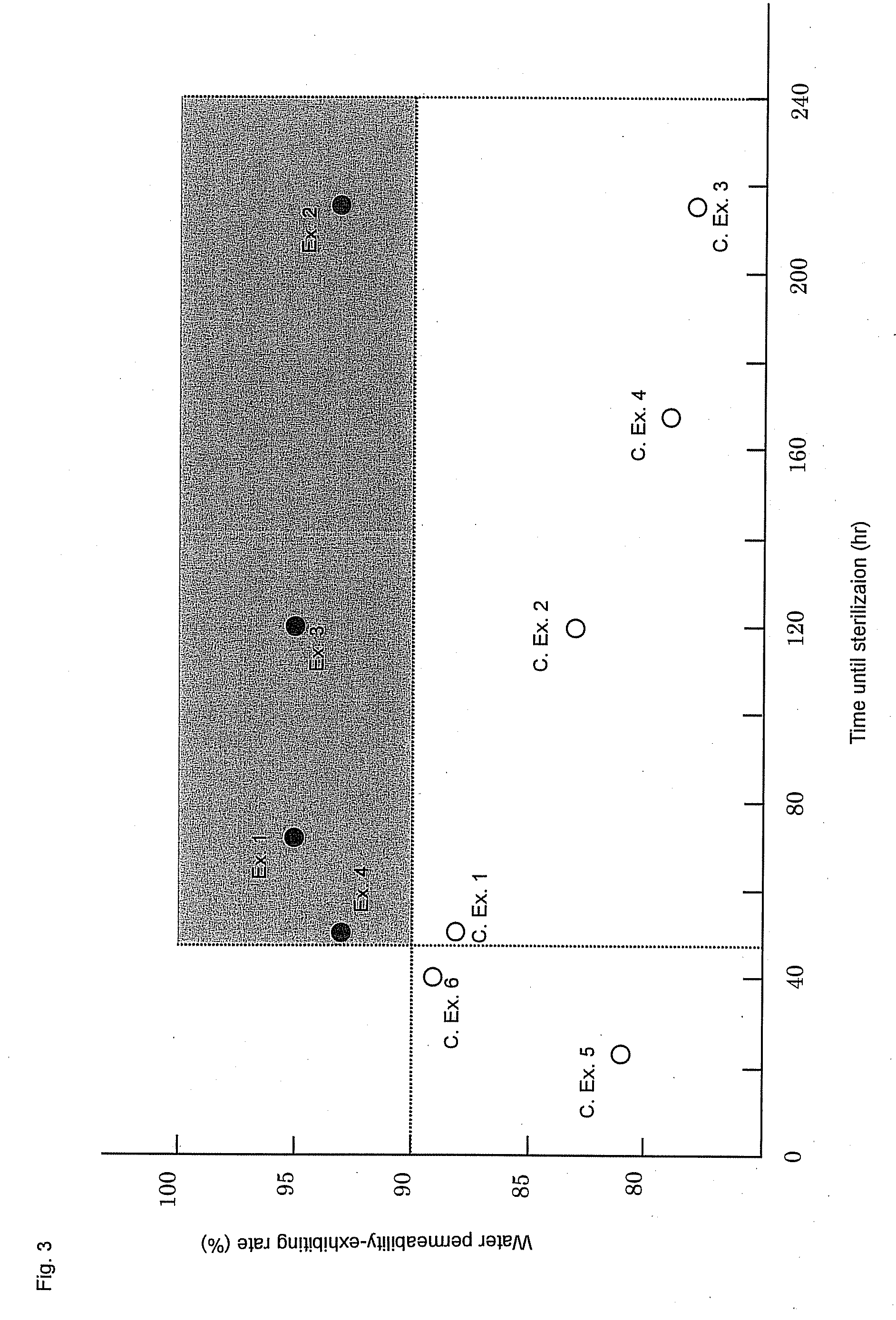Blood purifier
a purifier and blood technology, applied in the field of blood purifiers, can solve the problems of poor affinity of semipermeable membranes formed of polysulfone-based resins alone, inability to treat blood, air lock phenomenon, etc., and achieve high blood compatibility, excellent water permeability exhibiting, and high reliability in long-term storage stability.
- Summary
- Abstract
- Description
- Claims
- Application Information
AI Technical Summary
Benefits of technology
Problems solved by technology
Method used
Image
Examples
example 1
[0308]Polyethersulfone (Sumika-Excel® 4800P, manufactured by Sumika Chemtex Co., Ltd.) (1,000 mass parts), polyvinyl pyrrolidone (Colidone® K-90, manufactured by BASF) (144 mass parts) and dimethylacetoamide (DMAc) (1,000 mass parts) were charged in a knead-melting machine of the type which efficiently kneaded the mixture by way of so-called planetary motions of two frame type blades which rotated by themselves and rotated around each other. The mixture was stirred and kneaded for 2 hours. Subsequently, a solution mixture of DMAc (3,000 mass parts) and RO water (160 mass parts) was added to the knead mixture in one hour. The mixture was further stirred for one hour with the stirrer of which the number of revolutions was increased, to form a homogeneous solution. This kneading and dissolution was carried out under a nitrogen atmosphere. The mixture was kneaded and dissolved while being cooled so that its temperature did not exceed 40° C. The Froude number and the Reynolds number in t...
reference examples 1 and 2
[0319]Permselective hollow fiber membranes and blood purifiers were obtained in the same manners as in Example 1, except that the blood purifiers were tightly sealed in packaging bags and were then stored at room temperatures for 24 hours and for 40 hours, respectively, and then were exposed to γ-ray under the same conditions as in Example 1. The characteristics of the hollow fiber membranes and the blood purifiers are shown in Tables 1 to 3. In these Comparative Examples, because of the short periods of time from the sealing of the blood purifiers until the γ-ray exposure, the water permeability-exhibiting rates of the blood purifiers after the priming treatments were inferior to that of the blood purifier of Example 1. Accordingly, the blood purifiers of these Comparative Examples had low reliability in practical use. Also, it was known that the period of time from the sealing of the blood purifier to the γ-ray exposure gave some influence on the water permeability-exhibiting rate...
example 2
[0320]Polyethersulfone (Sumika-Excel® 4800P, manufactured by Sumika Chemtex Co., Ltd.) (1,000 mass parts), polyvinyl pyrrolidone (Colidone® K-90, manufactured by BASF) (200 mass parts) and DMAc (1,500 mass parts) were kneaded with a twin-screw type kneading machine. The knead mixture was introduced into a stirring type dissolution tank charged with DMAc (2,500 mass parts) and water (280 mass parts), and the mixture was stirred and dissolved for 3 hours. The mixture was kneaded and dissolved while the tank was being cooled so that the internal temperature did not exceed 30° C. Then, a vacuum pump was used to decompress the interior of the system to −700 mmHg, and the dissolution tank was immediately sealed so as not to change the composition of the membrane-forming solution due to the evaporation of the solvent or the like, and the dissolution tank was left to stand for 10 minutes. This operation was repeated three times to deaerate the membrane-forming solution. In this regard, poly...
PUM
| Property | Measurement | Unit |
|---|---|---|
| length | aaaaa | aaaaa |
| temperature | aaaaa | aaaaa |
| temperature | aaaaa | aaaaa |
Abstract
Description
Claims
Application Information
 Login to View More
Login to View More - R&D
- Intellectual Property
- Life Sciences
- Materials
- Tech Scout
- Unparalleled Data Quality
- Higher Quality Content
- 60% Fewer Hallucinations
Browse by: Latest US Patents, China's latest patents, Technical Efficacy Thesaurus, Application Domain, Technology Topic, Popular Technical Reports.
© 2025 PatSnap. All rights reserved.Legal|Privacy policy|Modern Slavery Act Transparency Statement|Sitemap|About US| Contact US: help@patsnap.com



